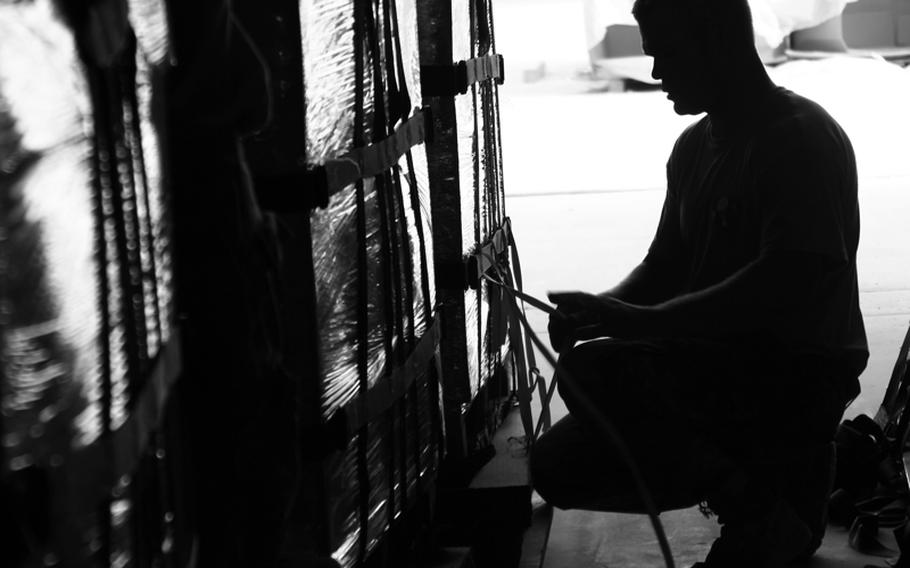
Spc. Shayne McKeever, assigned to the 824th Quartermaster, Detachment 10 from Ft. Bragg, N.C., rigs the Container Delivery System bundle to its base July 12, 2011. The rigging straps are part of the rigging process. Everyone in the 824th helps out. They operate at one-third the manpower, yet still deliver the same amount of supplies as any other rigging detachment at full strength. (Shannon R. Gregory/Courtesy U.S. Army)
WASHINGTON — As combat winds down and the military faces a budget crunch, the Army’s reserve forces are looking for new kinds of deployment opportunities and cheaper ways to train.
The Army Reserve and National Guard were pulled off the shelf to fight the wars of the last decade, rapidly transforming from strategic to operational forces. Now the challenge is to maintain that capability in a time of budget austerity, leaders said.
“To have an operational reserve, you have to have manned, trained and equipped units,” Lt. Gen. William Ingram, director of the Guard, told Stars and Stripes. “It’s not just being trained to be ready to operate, it’s actually going and doing it somewhere.”
Both Ingram and the chief of the Army Reserve, Lt. Gen. Jack Stultz, said they see opportunity in the new defense strategy that emphasizes small-footprint theater engagement around the world.
Stultz is set to retire this summer and be replaced by Lt. Gen. Jeff Talley.
In an outgoing interview with reporters last week, Stultz said he thinks the Reserve can begin extending its missions, such as an engineering project in the Philippines or a medical engagement in Central America, from a few weeks to a few months.
Commands like PACOM, AFRICOM and SOUTHCOM have to start integrating the reserves into their long-term planning, which “is not going to happen overnight,” he said.
Those kinds of continued deployments, though, are key to keeping top talent, Stultz said.
The Army risks losing part-time soldiers, he said, “if we don’t keep them engaged.”
However, unlike in the last decade when a soldier could have as much training and schooling as he asked for, Reserve soldiers will have to make do with their monthly drill weekends and yearly two-week training because money is no longer there.
Online training could take over for some drill weekends to make it more efficient.
“I think that’s something we’ve got to look at in the Reserves — how can we decentralize some of the training we’re doing so that the soldier doesn’t necessarily get in the car and drive?” Stultz said.
He also thinks the yearly two-week training doesn’t have to happen at Reserve facilities and, instead, soldiers could participate in active-duty exercises, which are funded already.
Ingram said there is a concern that the active duty will absorb all the available dollars, leaving the Reserves with little, similar to the pre-9/11 era.
Should sequestration budget cuts — about $500 billion in additional cuts — become a reality, the Pentagon will have to look elsewhere, Stultz said.
“We can’t generate the money needed out of the Reserve,” he said, noting that part-time soldiers are a minor piece of the budget despite carrying a huge load of the logistical needs. “It’s going to have to come out of the active.”